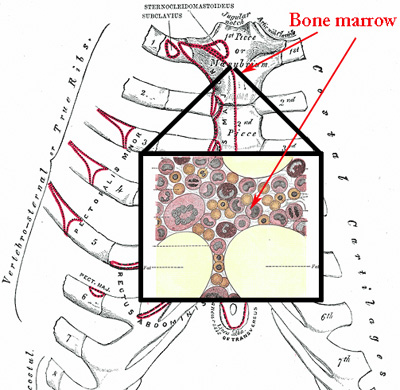Bone marrow

Bone marrow
Hematopoiesis is the formation of blood cells (erythrocytes, monocytes, granulocytes, platelets and lymphocytes). In the post-fetal life this takes place exclusively in the bone marrow, with exception for lymphocytes that are also formed in lymphoid tissues. In early life virtually all bones have an active bone marrow containing hematopoietic cells that participate in the formation of blood. Bone marrow display adipocytes with variable number of dispersed foci of hematopoietic cells. With increasing age, bone marrow at several sites is replaced by adipose tissue, either entirely, or only partially. The primary sites of blood formation are the vertebrae, sternum, ribs and pelvic bones. Bone marrow consisting entirely of fat is called yellow marrow, bone marrow with active hematopoiesis is referred to as red marrow.
Pluripotent hematopoietic stem cells give rise to all blood lineages, through cell division and subsequent differentiation starting from multipotent lymphoid stem cells (progenitors to lymphocytes) and multipotent myeloid stem cells (progenitors to red blood cells, neutrophils, monocytes and megakaryocytes). The stem cells are not possible to identify in HE-stained sections from the bone marrow, but various hematopoietic cells at different developmental levels can be identified by their different morphological signatures. The cell that is easiest to detect is the very large megakaryocyte that produces platelets.
|